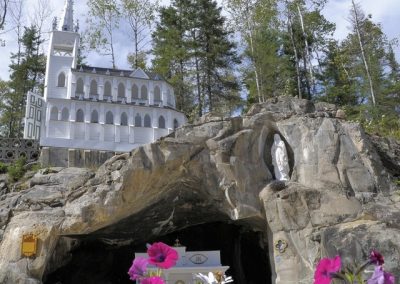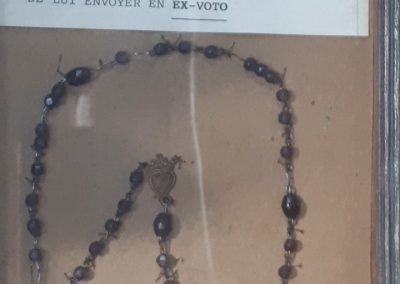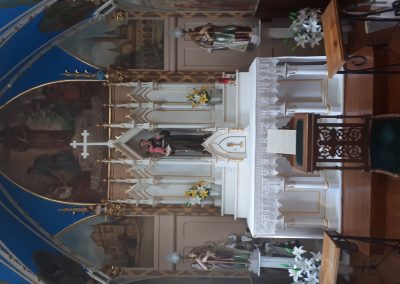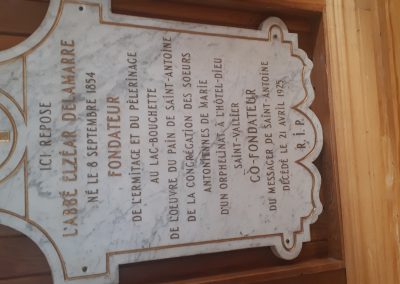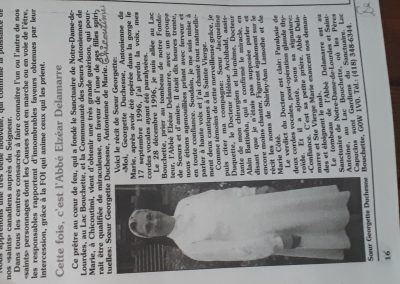The holy well of Lac-Bouchette
BIOGRAPHY OF FATHER ELZÉAR DELAMARRE:
Born on September 8, 1854 in Laval, Quebec, and moved with his family to Hébertville, Lac-Saint-Jean, in 1857, Father J.-B. Villeneuve saw in him a vocation. The latter paid for his studies. Despite his frail health, Father Delamarre was ordained priest on June 29, 1883.
In 1894, he founded the Bread of Saint Anthony to help young orphan girls. In 1895, he was the founder, with Father Huard, of the Messenger of Saint Anthony. In 1904, he created the Congregation of the Sisters of Saint Anthony of Padua and, in 1907, his major work, the Hermitage of Saint Anthony of Lac-Bouchette.
Two brothers, Charles DeLamarre (father of the famous Victor), and Father Elzéar DeLamarre, are at the origin of the project. Started as simply a place of residence for Charles DeLamarre and his family, Abbé Elzéar DeLamarre sees a very different potential in this sector. At that time, he was superior of the Chicoutimi seminary.
Abbé Delamarre in turn bought a very large piece of land, very close to his brother’s land. In 1906 he built his first small summer residence, and the following year, a house that would serve as a hermitage for only a few people, and a tiny chapel measuring four by five meters.
Delamarre was particularly devoted to Saint Anthony, following two spiritual journeys to Europe in 1891 and 1904. Inspired by these trips, he decided to consecrate the sanctuary in honor of Notre-Dame-de-Lourdes, where many miracles had already taken place.
This devotion to Lourdes and its miracles is not a coincidence, since Abbot DeLamarre had discovered on his land a grotto that strangely resembled the cult place of Europe. DeLamarre, impressed by the grotto, will install a statue of the Virgin Mary there, just like in Lourdes, but with the means of the region at that time THE DISCOVERY OF THE SOURCE OF PURE WATER
Yes, there were great similarities with the real Lourdes cave, but one important element was missing: the source of pure water. After some unsuccessful searches, Elzéar DeLamarre asked for the help of the Blessed Virgin. It was one of his nephews who, while digging in the hard rock, suddenly and miraculously brought forth a spring of gushing water. Analyses at the time showed that it was not mineral water, but absolutely pure water.
Later, Delamarre had a miniature reproduction of the basilica of Lourdes built just above the cave.
There, with the mini-basilica, the grotto, the statue of the Blessed Virgin and the pure water spring, the region now had its own little Notre-Dame-de-Lourdes.
All that was missing were miracles, which did not take long to arrive…
THE MIRACLES:
In the 1910s and well after, dozens of people from here and elsewhere say they were healed by this water, or by the simple fact of having visited the place.
Let’s go back to July 1920. A journalist from the newspaper La Presse, intrigued by all these rumors of cures, decided to go to Lac-Bouchette to collect testimonies. Here is what he was able to collect as information:
“One day, a woman arrived at the cave, barefoot. This woman explained to Mr. Delamare that she had been at death’s door, surrounded by her crying children whom she would not have liked to leave. She promised the Virgin to visit her shrine at Lac Bouchette barefoot if she recovered. She obtained this grace and it was her promise that she fulfilled. But she still had sciatica. After she fulfilled her devotions, this sciatica also disappeared, it was the second favor she obtained. »
“Mr. Rondeau, an electrical engineer, was suffering from an illness caused by mercury gas, and in the course of his work, was prone to hemorrhaging and was on the verge of death. He went to the sanctuary of Bouchette. Lying on the ground, he invoked the Blessed Virgin. He prayed for a long time and when he got up, he was completely healed. There were hardly any slight traces left. More than fifteen doctors had examined him before and declared him incurable, it is said. Mr. Rondeau now lives at Lac Bouchette where everyone can see him. As a reconnaissance, he is preparing a railroad that will lead pilgrims from the station to the cave. »
“Last winter, a man came back from the construction sites suffering from an axe wound that forced him to go to the hospital. Passing by Lac Bouchette, and forced to wait there for the next convoy, he heard the mistress of the house where he was staying tell him about the water in the new cave. She herself had some at home. The traveller’s wound was bathed in this water and the next day he was healed and was on his way back to his work site. »
The journalist mentioned about these miracles: “We would need a large space to tell about all the miracles performed at Notre-Dame-de-Lourdes from Lac Bouchette, or by the water in the grotto. »
THE SMILE OF THE VIRGIN:
Did the statue of Our Lady in the hermitage have moods? According to testimonies, it seems so. According to witnesses at the time, the Virgin seemed to smile at some people, but not at all.
One day, a man, a former Catholic who had abandoned his religion, went to the grotto in the company of Father DeLamarre. The man remarked to the religious that the statue was not smiling at all. DeLamarre confirmed this by telling him that indeed the Virgin had never seemed so sad to him. The man, overcome with guilt, asked the abbot, “Wouldn’t it be my fault? Immediately, he asked for confession and returned to his religion.
THE 1920s:
The 1920s marked a phenomenal growth in visits… and miracles. In 1922, a festival is organized for the blessing of a bridge. More than 3,000 people attended. A train full of people disembarked nearly 1,000 people at once. The boats have to make several trips to cross all these people.
If in 1925, the number of pilgrims had been 12,500. In 1926 the number double to more than 25,000. Chance or not, this coincided with the death of Father Delamarre, who died on April 21, 1925.
THE ECONOMIC CRISIS OF 1932:
Here, as elsewhere in the world, the economic crisis of the early 1930s hit hard. Many families are desperate because of this situation which pushes them to total destitution. The Hermitage of Saint-Antoine de Lac-Bouchette will serve as a gathering place to pray that this crisis will end and, of course, to ask the Blessed Virgin for immediate help.
In the summer of 1932, the shrine was faced with a flood of pilgrims from the region who came to do penance and ask for divine help. The population was exhausted. A march is organized. The Hermitage is the meeting place. In a few weeks, more than 1,500 people arrive from all over Lac-Saint-Jean, Jonquière, Kénogami, etc., and the pilgrims are all in a hurry.
After World War II:
We might believe that this hope for a miracle has diminished with modernity. No, on the contrary. Immediately after World War II, it was madness. In publications extolling the benefits of a stay at the Hermitage, hot and cold are blown. If on the one hand it is mentioned that a visit to this place can have miraculous virtues, on the other hand, the number of pilgrims must also be greatly limited, simply because of the lack of space and organization to accept all requests.
On this side, the promise is made of better days, but “that in the meantime, we will multiply the pilgrimages to less considerable groups, that is to say, with only a few hundred pilgrims at a time. »
This decision was taken following complaints from both pilgrims and Church authorities.
In retrospect, those who love this place for the right reasons will agree with not distorting its mission and avoiding it becoming an uncontrollable circus.
THERE ARE STILL MIRACLES:
Even today, this site remains a privileged place for many. Since the 1910’s, what started as a small second home has become the place we know. Constant and regular investments ensure the future of the hermitage.
These people arrive on foot. Many from Chambord where unemployment is appalling, but also the last inhabitants of Val-Jalbert, or even more than 400 people from Dolbeau, who had to walk the whole distance.
Lac-Bouchette village followed by organizing a walk to the place of worship, but barefoot! 160 people made the trip.
The village of Saint-François-de-Sales also invited itself with 60 pilgrims.
Obviously, it was not this outpouring of desperate people that stopped the economic crisis, but in a situation as difficult as it was at the time, we must admit that a little comfort was not completely useless.

